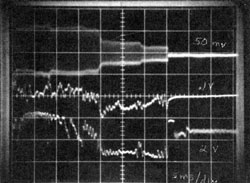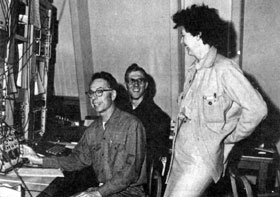Booster Achieves Full Design Beam Energy of Eight BeV
Another and a major milestone was achieved by the Booster section at approximately 2:20 a.m., Friday, May 21, when the Booster achieved its full design beam energy of 8 billion electron volts for the first time. The Booster is the second major accelerator in series used to accelerate protons in the NAL system. It is a rapid-cycling synchrotron approximately 500 feet in diameter.
The milestone was achieved under the direction of Helen Edwards, Booster section chief. Among others present were Harlan Gerzevske, Bob Peters, Ed Hubbard, John Sauer, of the Booster section, Curtis Owen, Jim Walker, Gerry Ortlieb, and Les Wahl of the Linac section. They were joined later in the early morning hours by Al Maschke, Bob Daniels and RRW. Also on hand in the West Gallery at the time of the Booster milestone were several members of the Radio-Frequency staff who were tuning the high level R.F. to its maximum power, including Quentin Kerns, Gerald Tool and Stan Tawzer.
The machine had been turned off the previous day for repairs and maintenance. It was turned on at about 8:00 p.m. on Thursday, May 20, and the energy gradually built up to the 8 BeV design level.
After the achievement, a party to observe the occasion was held by the Booster and Meson groups. The affair also served as a "farewell party" for Roy Billinge, who had served as head of the Booster section until recently when he took over direction of the Meson group. The Meson group consists primarily of people who were in the Booster section during its construction and they still aid in fabrication of special magnets. Billinge has accepted an appointment at Geneva, Switzerland, where he will become a member of the team assigned to develop and construct the new 300-GeV particle accelerator sponsored by the European Organization for Nuclear Research (CERN).
On December 14, 1970, the Booster section installed the last of 96 magnets in its "circle." At about 12:30 a.m., Saturday, January 23, 1971, a proton beam was injected from the Linac and "coasted" around the entire Booster accelerator ring for the first time. Protons were accelerated to 1 BeV in the Booster at 6:00 a.m., Saturday, February 6, 1971, a notable milestone for both the R.F. and the Booster sections.
Almost all of April was spent in a shakedown period on the Booster. The magnet power supply operated with good reliability and experiments were performed to accelerate the beam and give a 2 BeV beam to Beam Transfer for tune up. Most of the work was aimed toward achieving stable operation of the high power rf systems and on bringing the phase and radial feedback loops of the beam-controlled low-level rf system into operation.
Meantime, the Main Accelerator staff was busy tuning and coasting a low-energy proton beam from the Booster into the completed sectors of the Main Ring. At 7:10 a.m., Saturday, May 29, the beam had reached the B-21 point in the largest component of the NAL accelerator system.
As the power supply testing is underway, the Main Ring tunnel is being secured every night. Four two-man teams complete the search and close the interlock chains in approximately 90-minute periods.





